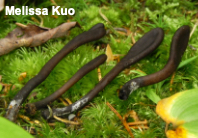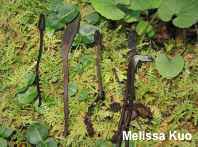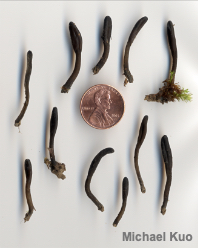| Major Groups > Clubs & Corals > Geoglossum umbratile |

|
Geoglossum umbratile [ Ascomycota > Geoglossales > Geoglossaceae > Geoglossum ... ] by Michael Kuo The little black "earth tongues" of the Geoglossaceae family are a nightmare to identify—but if you enjoy microscope work, they often reward you with fascinating and funky microscopic features. Geoglossum umbratile is among these mushrooms. To the naked eye, it is "distinct" in that its cap and stem are black, dry, and not finely velvety. This narrows things down to a handful of species, but you are not likely to get much further in the identification process without firing up the microscope. Geoglossum umbratile has amazing, septate (Mycologese for "partitioned by walls") spores that are packed side by side into its asci. The spores are almost always septate seven times (resulting in eight sections), and measure 55–90 µm long. Other defining microfeatures include the paraphyses, which have curved ends, and the fact that eight spores are packed into each ascus before they are shot out. Similar species abound, and include species of Glutinoglossum (with sticky surfaces) and Trichoglossum (with finely velvety surfaces), as well as other Geoglossum species that differ microscopically. Geoglossum nigritum is a synonym; the name represents a long history of misinterpretations of an 18th-century description of a very unrelated fungus (a member of the Basidiomycota, not even in the same phylum!). See Arauzo & Iglesias (2014) for details. There may be several cryptic species within "Geoglossum umbratile" in North America (and elsewhere), so the name should be applied with the understanding that a species group is probably designated. Description: Ecology: Saprobic; growing alone or gregariously on the ground in hardwood and conifer forests (sometimes growing on moss-covered logs); usually found among mosses; spring through and fall, or over winter in warm climates; originally described from Padua, Italy; widespread in Europe, Asia, Oceania, and North America. The described and illustrated collections are from Illinois, Michigan, North Carolina, and Pennsylvania. Fruiting Body: Club-shaped, with a well defined head that is clearly separate from the stem; 2–10 cm high. Head: 4–7 mm wide; often flattened and grooved once, longitudinally; black; bald; dry. Stem: 2–4 mm wide; sometimes becoming a little flattened; bald or very finely adorned with scurfy scales that are easily rubbed off; black or very dark brown; dry; basal mycelium pale gray. Flesh: Thin; black, or whitish in the center. Odor: Not distinctive. Microscopic Features: Spores 55–90 x 5–8 µm; cylindric to subfusiform or occasionally clavate; slightly curved; smooth; usually 7-septate (but sometimes varying); with black to dark brown walls in KOH. Asci 150–180 x 15–22.5 µm; fusiform; 8-spored. Paraphyses 2.5–5 µm wide; extending up to 20 µm beyond the asci; cylindric; apices up to 8 µm wide, subclavate, clavate, subcapitate, irregularly swollen, or merely rounded; often curved toward the apex; occasionally septate but not constricted at the septa; hyaline to brown in KOH. Cauloparaphyses similar to paraphyses; not gelatinized. REFERENCES: Saccardo, 1878. (Nannfeldt, 1942; Seaver, 1951; Mains, 1954; Smith, Smith & Weber, 1981; Breitenbach & Kränzlin, 1984; Kučera & Lizon, 2012; Arauzo & Iglesias, 2014; Beug et al., 2014; Læssøe & Petersen, 2019; MacKinnon & Luther, 2021; McKnight et al., 2021.) Herb. Kuo 06180303, 09120403, 05040703, 06230905, 07211401, 08091909. This website contains no information about the edibility or toxicity of mushrooms. |
© MushroomExpert.Com |
|
Cite this page as: Kuo, M. (2022, June). Geoglossum umbratile. Retrieved from the MushroomExpert.Com Web site: http://www.mushroomexpert.com/geoglossum_umbratile.html |




